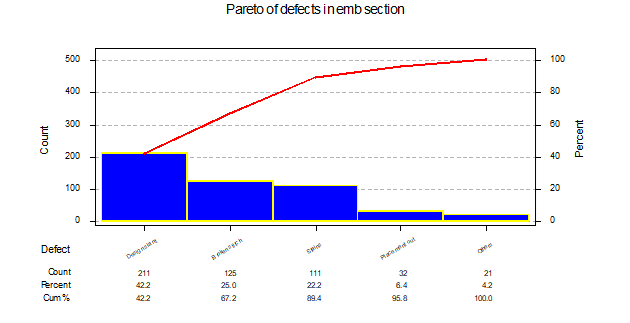Sreedher Kadambi and Badri Narayana, Flame TAO Knoware Pvt. Ltd.
Our previous blogs outlined our first 2 steps to implement a Six Sigma DMAIC approach for enhancing embroidery quality. These include the ‘defining’ and ‘measuring’ stages of the Six Sigma process in our associated apparel company. Here, we’ll continue to explore the DMAIC project that we carried out. Specifically, let’s look into the ‘A’ of DMAIC – analysing the root causes of issues and developing countermeasures!
Analyse: The Root Causes and Develop Countermeasures
Following the first two steps, we then decided to analyse the data which we had collected during the ‘measure’ phase of the project. We carried out the analysis using a Pareto diagram (figure 1).

Figure 1 – Pareto of defects that were found in the embroidery section
Therefore, based on this Pareto diagram, we could see 3 categories contributing to over 90% of the overall defects. Do you think these categories will change with the varying styles? The chances of this happening are very less, because the design slant, broken stitches, and stains are more process-centric than product-centric in nature. Additionally, no defect can vanish by itself. You’ll have to change something in the process to trigger a transition in the result. Hence, we decided to brainstorm possibilities about the root causes of the defects. Most importantly, we constructed countermeasures for these (table 1). For example, here’s how we identified the root cause of a problem:
- The embroidery was slant. Why was it so?
- This is because the marking was slant? Why was this the case?
- This is a result of the unclear grain lines beneath the pattern. Consequently, they caused inaccurate markings.
- This is because the marking was slant? Why was this the case?
Therefore, the root cause of this problem was the opaque pattern used by the marker. Resultantly, the countermeasure we derived was to make the pattern transparent.

Table 1 – The team discovered the countermeasures for the prioritized categories
During this time, the causes of the broken stitch were not known. Hence, we decided to implement the countermeasures which had been discovered without further delay. Above all, always remember that there’s only one way to truly uncover a countermeasure’s efficacy – i.e., by carrying out a pilot! Now that we’ve understood the ‘analyse’ phase of the DMAIC project, let’s take a look at the next one.
